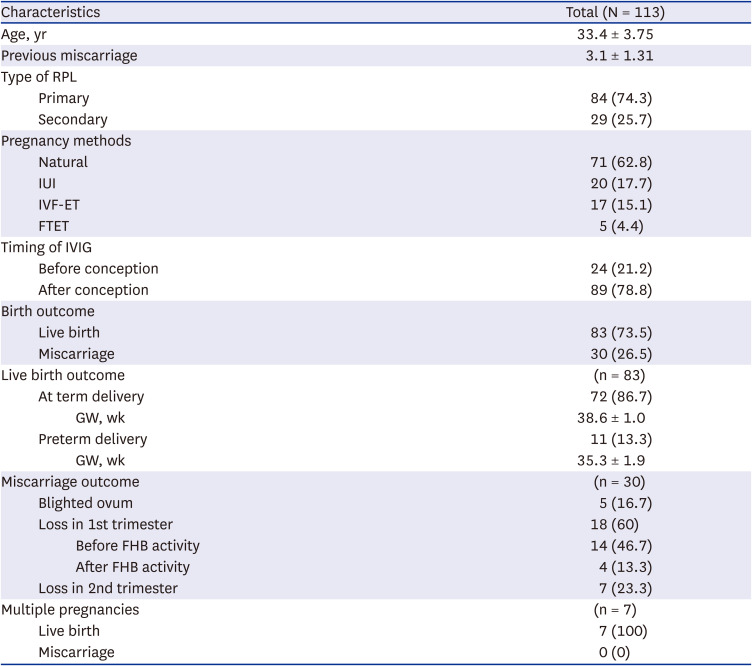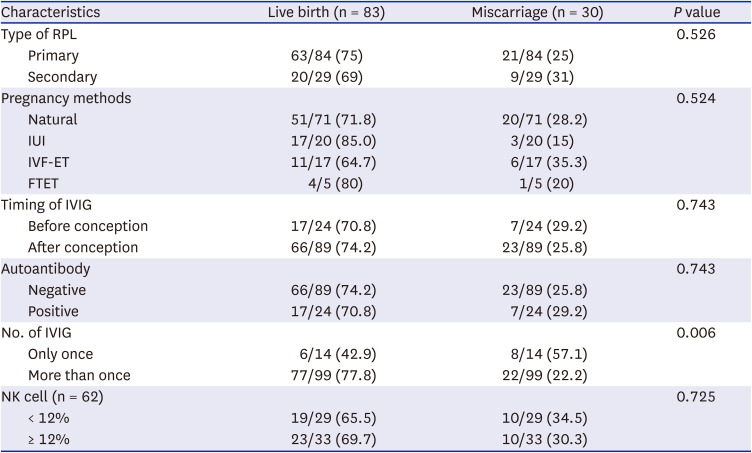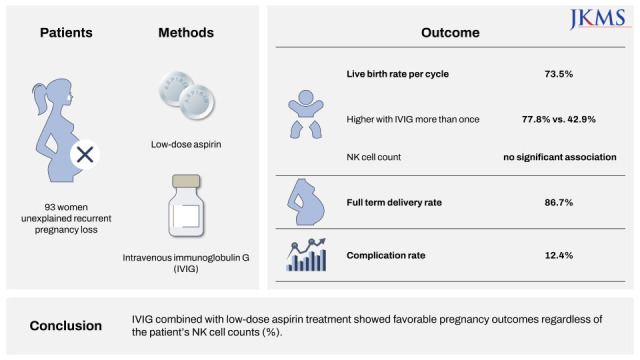1. Ford HB, Schust DJ. Recurrent pregnancy loss: etiology, diagnosis, and therapy. Rev Obstet Gynecol. 2009; 2(2):76–83. PMID:
19609401.
2. Practice Committee of the American Society for Reproductive Medicine. Definitions of infertility and recurrent pregnancy loss: a committee opinion. Fertil Steril. 2020; 113(3):533–535. PMID:
32115183.
3. ESHRE Guideline Group on RPL. Bender Atik R, Christiansen OB, Elson J, Kolte AM, Lewis S, et al. ESHRE guideline: recurrent pregnancy loss. Hum Reprod Open. 2018; 2018(2):hoy004. PMID:
31486805.

4. Christiansen OB, Kolte AM, Krog MC, Nielsen HS, Egerup P. Treatment with intravenous immunoglobulin in patients with recurrent pregnancy loss: an update. J Reprod Immunol. 2019; 133:37–42. PMID:
31238263.

5. Philipp T, Philipp K, Reiner A, Beer F, Kalousek DK. Embryoscopic and cytogenetic analysis of 233 missed abortions: factors involved in the pathogenesis of developmental defects of early failed pregnancies. Hum Reprod. 2003; 18(8):1724–1732. PMID:
12871891.

6. Achilli C, Duran-Retamal M, Saab W, Serhal P, Seshadri S. The role of immunotherapy in in vitro fertilization and recurrent pregnancy loss: a systematic review and meta-analysis. Fertil Steril. 2018; 110(6):1089–1100. PMID:
30396553.

7. Hou Y, Li J, Liu Q, Zhang L, Chen B, Li Y, et al. The optimal timing of immunotherapy may improve pregnancy outcome in women with unexplained recurrent pregnancy loss: a perspective follow-up study in northeastern China. Am J Reprod Immunol. 2020; 83(4):e13225. PMID:
31985860.

8. Ramos-Medina R, García-Segovia A, Gil J, Carbone J, Aguarón de la Cruz A, Seyfferth A, et al. Experience in IVIg therapy for selected women with recurrent reproductive failure and NK cell expansion. Am J Reprod Immunol. 2014; 71(5):458–466. PMID:
24612159.

9. Han AR, Lee SK. Immune modulation of i.v. immunoglobulin in women with reproductive failure. Reprod Med Biol. 2018; 17(2):115–124. PMID:
29692668.

10. Saini V, Arora S, Yadav A, Bhattacharjee J. Cytokines in recurrent pregnancy loss. Clin Chim Acta. 2011; 412(9-10):702–708. PMID:
21236247.

11. Beer AE, Kwak JY, Ruiz JE. Immunophenotypic profiles of peripheral blood lymphocytes in women with recurrent pregnancy losses and in infertile women with multiple failed in vitro fertilization cycles. Am J Reprod Immunol. 1996; 35(4):376–382. PMID:
8739457.

12. Moraru M, Carbone J, Alecsandru D, Castillo-Rama M, García-Segovia A, Gil J, et al. Intravenous immunoglobulin treatment increased live birth rate in a Spanish cohort of women with recurrent reproductive failure and expanded CD56
+ cells. Am J Reprod Immunol. 2012; 68(1):75–84. PMID:
22509929.

13. Coulam CB, Goodman C. Increased pregnancy rates after IVF/ET with intravenous immunoglobulin treatment in women with elevated circulating C56+ cells. Early Pregnancy (Cherry Hill). 2000; 4(2):90–98. PMID:
11723539.
14. Perricone R, Di Muzio G, Perricone C, Giacomelli R, De Nardo D, Fontana L, et al. High levels of peripheral blood NK cells in women suffering from recurrent spontaneous abortion are reverted from high-dose intravenous immunoglobulins. Am J Reprod Immunol. 2006; 55(3):232–239. PMID:
16451358.

15. Stricker RB, Steinleitner A, Bookoff CN, Weckstein LN, Winger EE. Successful treatment of immunologic abortion with low-dose intravenous immunoglobulin. Fertil Steril. 2000; 73(3):536–540. PMID:
10689009.

16. Li J, Chen Y, Liu C, Hu Y, Li L. Intravenous immunoglobulin treatment for repeated IVF/ICSI failure and unexplained infertility: a systematic review and a meta-analysis. Am J Reprod Immunol. 2013; 70(6):434–447. PMID:
24238107.

17. Triggianese P, Lattavo G, Chimenti MS, Conigliaro P, Perricone R, Perricone C, et al. Reproductive outcomes 20 years after the intravenous immunoglobulin treatment in women with recurrent pregnancy losses. Am J Reprod Immunol. 2020; 83(4):e13224. PMID:
31971295.

18. Stephenson MD, Kutteh WH, Purkiss S, Librach C, Schultz P, Houlihan E, et al. Intravenous immunoglobulin and idiopathic secondary recurrent miscarriage: a multicentered randomized placebo-controlled trial. Hum Reprod. 2010; 25(9):2203–2209. PMID:
20634190.

19. Christiansen OB, Larsen EC, Egerup P, Lunoee L, Egestad L, Nielsen HS. Intravenous immunoglobulin treatment for secondary recurrent miscarriage: a randomised, double-blind, placebo-controlled trial. BJOG. 2015; 122(4):500–508. PMID:
25412569.

20. Dolitzky M, Inbal A, Segal Y, Weiss A, Brenner B, Carp H. A randomized study of thromboprophylaxis in women with unexplained consecutive recurrent miscarriages. Fertil Steril. 2006; 86(2):362–366. PMID:
16769056.

21. Li J, Gao YH, Xu L, Li ZY. Meta-analysis of heparin combined with aspirin versus aspirin alone for unexplained recurrent spontaneous abortion. Int J Gynaecol Obstet. 2020; 151(1):23–32. PMID:
32535924.

22. Carreras LD, Perez GN, Vega HR, Casavilla F. Lupus anticoagulant and recurrent fetal loss: successful treatment with gammaglobulin. Lancet. 1988; 332(8607):393–394.

23. The German RSA/IVIG Group. Intravenous immunoglobulin in the prevention of recurrent miscarriage. Br J Obstet Gynaecol. 1994; 101(12):1072–1077. PMID:
7826961.
24. Coulam CB, Krysa L, Stern JJ, Bustillo M. Intravenous immunoglobulin for treatment of recurrent pregnancy loss. Am J Reprod Immunol. 1995; 34(6):333–337. PMID:
8607936.

25. Stephenson MD, Fluker MR. Treatment of repeated unexplained in vitro fertilization failure with intravenous immunoglobulin: a randomized, placebo-controlled Canadian trial. Fertil Steril. 2000; 74(6):1108–1113. PMID:
11119735.

26. Mumford SL, Silver RM, Sjaarda LA, Wactawski-Wende J, Townsend JM, Lynch AM, et al. Expanded findings from a randomized controlled trial of preconception low-dose aspirin and pregnancy loss. Hum Reprod. 2016; 31(3):657–665. PMID:
26759138.

27. Blomqvist L, Hellgren M, Strandell A. Acetylsalicylic acid does not prevent first-trimester unexplained recurrent pregnancy loss: a randomized controlled trial. Acta Obstet Gynecol Scand. 2018; 97(11):1365–1372. PMID:
29972884.

28. Naimi AI, Perkins NJ, Sjaarda LA, Mumford SL, Platt RW, Silver RM, et al. The effect of preconception-initiated low-dose aspirin on human chorionic gonadotropin-detected pregnancy, pregnancy loss, and live birth : per protocol analysis of a randomized trial. Ann Intern Med. 2021; 174(5):595–601. PMID:
33493011.

29. Wang SW, Zhong SY, Lou LJ, Hu ZF, Sun HY, Zhu HY. The effect of intravenous immunoglobulin passive immunotherapy on unexplained recurrent spontaneous abortion: a meta-analysis. Reprod Biomed Online. 2016; 33(6):720–736. PMID:
27720163.

30. Woon EV, Day A, Bracewell-Milnes T, Male V, Johnson M. Immunotherapy to improve pregnancy outcome in women with abnormal natural killer cell levels/activity and recurrent miscarriage or implantation failure: a systematic review and meta-analysis. J Reprod Immunol. 2020; 142:103189. PMID:
32889304.

31. Saab W, Seshadri S, Huang C, Alsubki L, Sung N, Kwak-Kim J. A systemic review of intravenous immunoglobulin G treatment in women with recurrent implantation failures and recurrent pregnancy losses. Am J Reprod Immunol. 2021; 85(4):e13395. PMID:
33511656.

32. Egerup P, Lindschou J, Gluud C, Christiansen OB. ImmuReM IPD Study Group. The effects of intravenous immunoglobulins in women with recurrent miscarriages: a systematic review of randomised trials with meta-analyses and trial sequential analyses including individual patient data. PLoS One. 2015; 10(10):e0141588. PMID:
26517123.

33. Nyborg KM, Kolte AM, Larsen EC, Christiansen OB. Immunomodulatory treatment with intravenous immunoglobulin and prednisone in patients with recurrent miscarriage and implantation failure after in vitro fertilization/intracytoplasmic sperm injection. Fertil Steril. 2014; 102(6):1650–1655.e1. PMID:
25256927.
34. Sung N, Han AR, Park CW, Park DW, Park JC, Kim NY, et al. Intravenous immunoglobulin G in women with reproductive failure: the Korean Society for Reproductive Immunology practice guidelines. Clin Exp Reprod Med. 2017; 44(1):1–7. PMID:
28428937.

35. Ahmadi M, Aghdam SA, Nouri M, Babaloo Z, Farzadi L, Ghasemzadeh A, et al. Intravenous immunoglobulin (IVIG) treatment modulates peripheral blood Th17 and regulatory T cells in recurrent miscarriage patients: non randomized, open-label clinical trial. Immunol Lett. 2017; 192:12–19. PMID:
29030251.

36. Lee SK, Kim JY, Han AR, Hur SE, Kim CJ, Kim TH, et al. Intravenous immunoglobulin G improves pregnancy outcome in women with recurrent pregnancy losses with cellular immune abnormalities. Am J Reprod Immunol. 2016; 75(1):59–68. PMID:
26510488.

37. Meng L, Lin J, Chen L, Wang Z, Liu M, Liu Y, et al. Effectiveness and potential mechanisms of intralipid in treating unexplained recurrent spontaneous abortion. Arch Gynecol Obstet. 2016; 294(1):29–39. PMID:
26671484.

38. Nazari Z, Ghaffari J, Ebadi A. Comparison of the effect of aspirin and heparin with or without intravenous immunoglobulin in treatment of recurrent abortion with unknown etiology: a clinical study. J Nat Sci Biol Med. 2015; 6(3):Suppl 1. S17–S21. PMID:
26604612.

39. Tang AW, Alfirevic Z, Quenby S. Natural killer cells and pregnancy outcomes in women with recurrent miscarriage and infertility: a systematic review. Hum Reprod. 2011; 26(8):1971–1980. PMID:
21613313.

40. Jørgensen MM, Bæk R, Sloth J, Varming K, Christiansen OB, Ditlevsen NE, et al. Treatment with intravenous immunoglobulin increases the level of small EVs in plasma of pregnant women with recurrent pregnancy loss. J Reprod Immunol. 2020; 140:103128. PMID:
32330775.








 PDF
PDF Citation
Citation Print
Print




 XML Download
XML Download